The humble bread stick. My first effort at these probably wouldn't impress any serious baker, but for my first attempt I was rather pleased with them.
An ever-reliable party nibble, the bread stick originates from Turin, and (according to Wikipedia) was apparently first made as far back as the 14th century.
 |
| Kneaded and ready to rise... |
 |
| An hour later... Linda Collister recommends that a slightly under-sized dough is preferable to an over-risen one for this recipe |
 |
| Rolling out ready for cutting |
 |
| Shaped and ready for the oven |
A word on the sponge method
Collister's basic technique for bread-making includes a stage where you leave the batter to "sponge". With the grissini, this stage comes after you have added the salt and yeast (I used fast-action dried yeast) - always remembering to add them on separate sides of the bowl of course - and poured the water and oil into a well in the middle. The idea is to then draw a little flour into the liquid and then leave it to "sponge" for about 20 minutes - basically to become aerated and frothy.
This is the so-called "half-sponge method". This is not a technique that I have used with any of the previous breads I have made. I can't say that I was able to notice any discernible difference; however, I think to really notice the difference in flavour you would have to leave the batter to "sponge" for at least a couple of hours. Dan Lepard's recipe for "the easiest loaf in the world" uses the half-sponge method (warm water, yeast and flour left for a couple of hours, or even overnight if possible).
